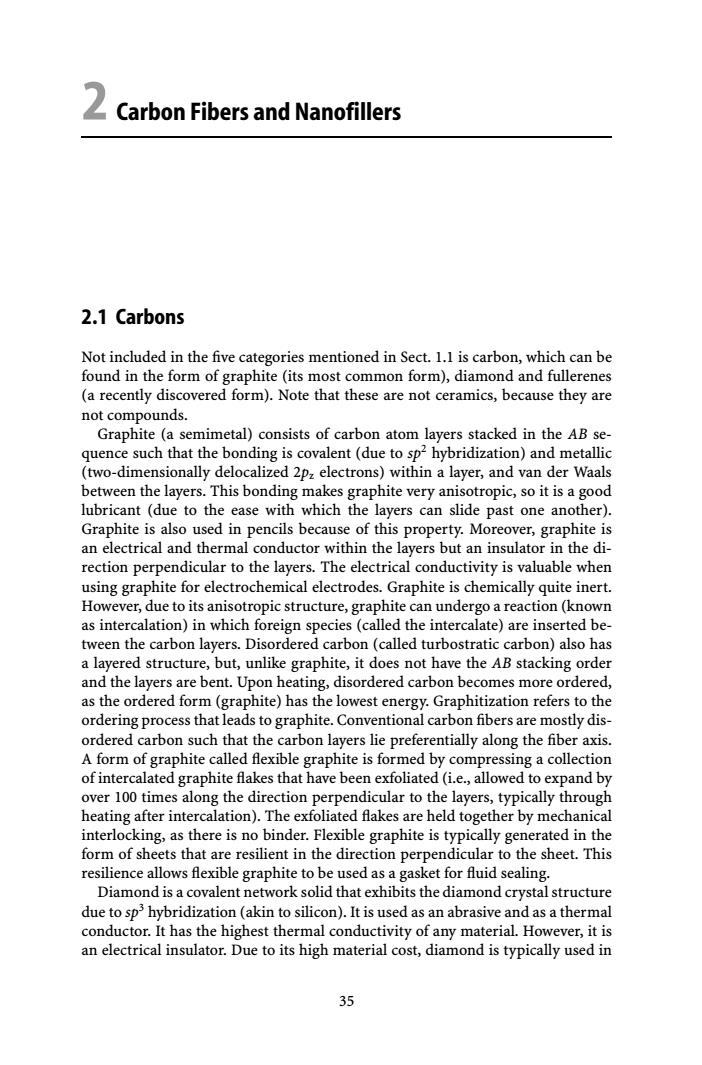正在加载图片...

2 Carbon Fibers and Nanofillers 2.1 Carbons Not included in the five categories mentioned in Sect.1.1 is carbon,which can be found in the form of graphite (its most common form),diamond and fullerenes (a recently discovered form).Note that these are not ceramics,because they are not compounds. Graphite (a semimetal)consists of carbon atom layers stacked in the AB se- quence such that the bonding is covalent(due to sp-hybridization)and metallic (two-dimensionally delocalized 2pz electrons)within a layer,and van der Waals between the layers.This bonding makes graphite very anisotropic,so it is a good lubricant (due to the ease with which the layers can slide past one another). Graphite is also used in pencils because of this property.Moreover,graphite is an electrical and thermal conductor within the layers but an insulator in the di- rection perpendicular to the layers.The electrical conductivity is valuable when using graphite for electrochemical electrodes.Graphite is chemically quite inert. However,due to its anisotropic structure,graphite can undergo a reaction(known as intercalation)in which foreign species(called the intercalate)are inserted be- tween the carbon layers.Disordered carbon (called turbostratic carbon)also has a layered structure,but,unlike graphite,it does not have the AB stacking order and the layers are bent.Upon heating,disordered carbon becomes more ordered, as the ordered form(graphite)has the lowest energy.Graphitization refers to the ordering process that leads to graphite.Conventional carbon fibers are mostly dis- ordered carbon such that the carbon layers lie preferentially along the fiber axis. A form of graphite called flexible graphite is formed by compressing a collection of intercalated graphite flakes that have been exfoliated (i.e.,allowed to expand by over 100 times along the direction perpendicular to the layers,typically through heating after intercalation).The exfoliated flakes are held together by mechanical interlocking,as there is no binder.Flexible graphite is typically generated in the form of sheets that are resilient in the direction perpendicular to the sheet.This resilience allows flexible graphite to be used as a gasket for fluid sealing. Diamond is a covalent network solid that exhibits the diamond crystal structure due to sp'hybridization(akin to silicon).It is used as an abrasive and as a thermal conductor.It has the highest thermal conductivity of any material.However,it is an electrical insulator.Due to its high material cost,diamond is typically used in 352 Carbon Fibers and Nanofillers 2.1 Carbons Not included in the five categories mentioned in Sect. 1.1 is carbon, which can be found in the form of graphite (its most common form), diamond and fullerenes (a recently discovered form). Note that these are not ceramics, because they are not compounds. Graphite (a semimetal) consists of carbon atom layers stacked in the AB sequence such that the bonding is covalent (due to sp2 hybridization) and metallic (two-dimensionally delocalized 2pz electrons) within a layer, and van der Waals between the layers. This bonding makes graphite very anisotropic, so it is a good lubricant (due to the ease with which the layers can slide past one another). Graphite is also used in pencils because of this property. Moreover, graphite is an electrical and thermal conductor within the layers but an insulator in the direction perpendicular to the layers. The electrical conductivity is valuable when using graphite for electrochemical electrodes. Graphite is chemically quite inert. However, due to its anisotropic structure, graphite can undergo a reaction (known as intercalation) in which foreign species (called the intercalate) are inserted between the carbon layers. Disordered carbon (called turbostratic carbon) also has a layered structure, but, unlike graphite, it does not have the AB stacking order and the layers are bent. Upon heating, disordered carbon becomes more ordered, as the ordered form (graphite) has the lowest energy. Graphitization refers to the ordering process that leads to graphite. Conventional carbon fibers are mostly disordered carbon such that the carbon layers lie preferentially along the fiber axis. A form of graphite called flexible graphite is formed by compressing a collection of intercalated graphite flakes that have been exfoliated (i.e., allowed to expand by over 100 times along the direction perpendicular to the layers, typically through heating after intercalation). The exfoliated flakes are held together by mechanical interlocking, as there is no binder. Flexible graphite is typically generated in the form of sheets that are resilient in the direction perpendicular to the sheet. This resilience allows flexible graphite to be used as a gasket for fluid sealing. Diamond is a covalent network solid that exhibits the diamond crystal structure due to sp3 hybridization (akin to silicon). It is used as an abrasive and as a thermal conductor. It has the highest thermal conductivity of any material. However, it is an electrical insulator. Due to its high material cost, diamond is typically used in 35